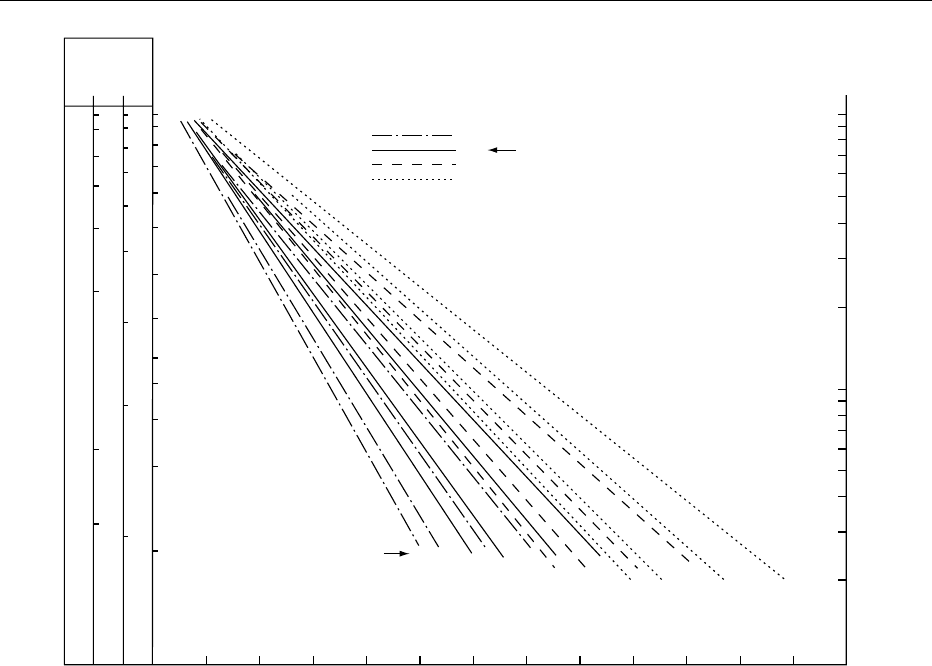Caballero B. (ed.) Encyclopaedia of Food Science, Food Technology and Nutrition. Ten-Volume Set
Подождите немного. Документ загружается.


‘coolant’ remains at a constant 0
C until all the ice
has turned into water. The process is labor-intensive,
although automatic filling systems have been de-
veloped. Cabbage and root crops are also cooled
with crushed ice.
Vacuum Cooling
0018 Solid products with a large surface area-to-volume
ratio and an ability to release internal water are
amenable to vacuum cooling. The products are
placed in a vacuum chamber, and the resultant evap-
orative cooling removes heat from the food. In gen-
eral terms, a 5
C reduction in product temperature is
achieved for every 1% of water that is evaporated.
Prewetting is commonly applied to facilitate cooling
without any loss of weight.
0019 Vacuum cooling is rapid and economical to operate
because of low labor costs, but the capital cost of
the large vacuum vessels is high. Large amounts of
lettuce, celery, cauliflower, green peas, and sweetcorn
are vacuum-cooled.
Cryogenic Cooling
0020 Avoiding surface freezing of the product is the main
problem in using liquid nitrogen or solid carbon di-
oxide for chilling. Continuous chilling systems using
liquid nitrogen either immerse the product in the
liquid, spray the nitrogen on to the surface, or vapor-
ize the nitrogen in a forced draught and pass it over
the surface of the foodstuff.
0021 Direct spraying of liquid nitrogen on to a food
product, whilst it is conveyed through an insulated
tunnel, is the most common method. Surface freezing
is still a problem, but an extra refrigeration effect is
obtained by precooling the food with the cold gas
produced by the vaporization.
Chilling Methods for Liquid Foodstuffs
0022 The majority of liquid foodstuffs require cooling after
a heat-processing operation such as cooking, pasteur-
ization, or sterilization. Milk is cooled at the point of
collection to maintain its quality, unpasteurized fruit
juices are cooled immediately after production, whilst
fermented beverages are often cooled during primary
and secondary fermentation, and before storage. (See
Fermented Milks: Products from Northern Europe;
Milk: Processing of Liquid Milk; Pasteurization:
Principles.)
0023 In simple or small-scale processes, containers of hot
liquids are allowed to cool in ambient air or placed
inside chill rooms. Other cooling systems for liquid
foods rely on direct expansion refrigeration, the use
of a secondary refrigerant that is passed through or
around the foodstuff, vacuum cooling, or a combin-
ation of liquid and vacuum.
0024Batch coolers for liquid foods range in capacity
from 100 to 10 000 l with the foodstuff contained in
a stainless steel vessel. The cooling medium may cir-
culate through the jacket of the vessel, through a coil
immersed in the liquid, or both. Most vessels are
provided with agitators to improve convective heat
transfer and stop temperature stratification. One
common method used to decrease cooling times in a
closed vessel is to apply a vacuum to produce
evaporative cooling.
0025Continuous cooling used to be achieved in falling
film or surface coolers in which the hot liquid was
pumped over the top of a horizontal bank of refriger-
ated coils and flowed down over the cooled surfaces.
These systems have now been replaced by totally
enclosed coolers. Double-pipe coolers have also
been employed in specialized applications but have a
limited heat-transfer surface. Multiplate coolers are
extensively used for liquid foods. They have the
highest available heat-transfer surface, lowest mater-
ial requirements, and maximum efficiency, and are
very flexible in operation and easy to clean. In certain
applications, such as beer and wine cooling, multi-
tube coolers that have a much higher resistance to
pressure and can use primary refrigerants have
advantages over multiplate coolers.
0026Scraped surface heat exchangers can have advan-
tages in the cooling of very viscous liquid foods and
where surface fouling is a potential problem. Cur-
rently, there is interest in the use of pumpable ice in
the form of an ice ‘pig’ to clean heat exchangers and
pipeline systems for liquid foods.
Chilled Storage
0027Theoretically, there are clear differences between the
environmental conditions required for chilling, which
is a heat removal/temperature reduction process, and
storage where the aim is to maintain temperature.
However, in many air-based systems, chilling and
storage take place in the same chamber, and even
where two separate facilities are used, in many cases,
not all the required heat is removed in the chilling
phase. With some fruits and vegetables, the rate of
respiration during storage is sufficient to require heat
removal if product quality is to be maintained. (See
Storage Stability: Mechanisms of Degradation;
Parameters Affecting Storage Stability.)
Bulk Storage Rooms
0028Most unwrapped meat and poultry and all types of
wrapped foods are stored in large air-circulated
1166 CHILLED STORAGE/Principles

rooms. To minimize weight loss, air movement
around the unwrapped product should be the min-
imum required to maintain a constant temperature.
With wrapped products, low air velocities are also
desirable to minimize energy consumption. However,
many storage rooms are designed and constructed
with little regard to air distribution and the mainten-
ance of low localized velocities over products. Hori-
zontal throw refrigeration coils are often mounted in
the free space above the racks or rails of product, and
no attempt is made to distribute the air around the
products. Using air socks, it is claimed that an even
air distribution can be maintained with localized
velocities not exceeding 0.2 m s
1
.
Controlled-atmosphere Storage Rooms
0029 Controlled-atmosphere storage rooms were de-
veloped for specialized fruit stores, especially those
for apples. Interest is growing in the application of this
technique to other commodities including meat and
fish. In addition to the normal temperature control
plant, these stores also include special gas-tight seals
to maintain an atmosphere, which is normally lower
in oxygen and higher in nitrogen and carbon dioxide
than air. An additional plant is required to control the
CO
2
concentration, generate nitrogen and consume
oxygen. (See Controlled-atmosphere Storage: Appli-
cations for Bulk Storage of Foodstuffs.)
0030 There is growing interest in the use of controlled
atmosphere retail packs to extend the chilled storage
and display life of meat and meat products. Since the
packs insulate the products, efficient precooling before
packaging is important.
Transportation
0031 Developments in temperature-controlled transporta-
tion systems for products have been one of the main
factors leading to the rapid expansion of the chilled
food market. The sea transportation of chilled meat
from Australasia to European and other distant
markets, and road transportation of chilled products
throughout Europe and the Middle East, are now
common practice. Air freighting was initially used
for high-value perishable products such as straw-
berries, asparagus, and live lobsters. It is now increas-
ingly used to provide consumers with a year-round
supply of locally out-of-season products such as green
beans, mangetout, and green on carrots.
Overland Transport
0032 Overland transportation systems range from 12-m
refrigerated containers for long-distance road or
rail movement of bulk chilled products to small
uninsulated vans supplying food to local retail
outlets. The majority of current road transport
vehicles for chilled foods are refrigerated using either
mechanical, eutectic plates or liquid nitrogen cooling
systems.
0033Many types of independent engine and/or electric
motor-driven mechanical refrigeration units are avail-
able for lorries or trailers. One of the most common is
a self-contained ‘plug’ unit mounted in an opening
provided in the front wall of the vehicle. The condens-
ing section is on the outside and the evaporator on the
inside of the unit, separated by an insulated section,
which fits into the gap in the wall. Units have one or
two compressors, depending upon their capacity,
which can be belt-driven from the vehicle but are
usually driven direct from an auxiliary engine. This
engine may use petrol from the vehicle’s supply or an
independent tank, or liquid petroleum gas. Many are
equipped with an additional electric motor for standby
use or for quiet running, e.g., when parked or on a
ferry. Irrespective of the type of refrigeration equip-
ment used, the product will not be maintained at its
desired temperature during transportation unless it is
surrounded by air or surfaces at or below that tem-
perature. This is usually achieved by a system that
circulates moving air, either forced or by gravity,
around the load. Inadequate air distribution is prob-
ably the principal cause of product deterioration and
loss of shelf-life during transport. Conventional forced
air units usually discharge air over the stacked or
suspended products either directly from the evapor-
ator or through ducts towards the rear cargo doors.
Because air takes the path of least resistance, it circu-
lates through the channels, which have the largest
cross-sectional area. These tend to be around, rather
than through, the product. If products have been
cooled to the correct temperature before loading and
do not generate heat, they only have to be isolated
from external heat ingress. Many trucks are now
being constructed with an inner skin that forms a
return air duct along the side walls and floor, with
the refrigerated air being supplied via a ceiling duct.
Sea Transport
0034Recent developments in temperature control, pack-
aging, and controlled atmospheres have increased
substantially the range of foods that can be trans-
ported around the world in a chilled condition.
Control of the oxygen and carbon dioxide levels in
shipboard containers has allowed fruits and vege-
tables such as apples, pears, avocado pears, melons,
mangoes, nectarines, blueberries, and asparagus to be
shipped from Australia and New Zealand to markets
in the USA, Europe, Middle East, and Japan. With
conventional vacuum packing, it is difficult to achieve
a shelf-life in excess of 12 weeks with beef and 8
CHILLED STORAGE/Principles 1167

weeks for lamb. However, a study has found that a
shelf-life of up to 23 weeks at 2
C can be achieved
in cuts of lamb that are individually packed in evacu-
ated bags of linear polyethylene, and then placed in a
foil laminate bag that is gas-flushed and filled with
a volume of CO
2
approximately equal to that of
the meat. Similar storage lives are currently being
achieved with beef primals transported from Austra-
lia and South Africa to the EU. Assuming good stand-
ards of preparation and prompt cooling, the times
given in Table 1 could be used as approximate guide-
lines for long-distance meat shipment.
0035 These times rely on the meat being at or below the
storage temperature before loading. The 2– 4-week
advantage of transporting meat at 1.5
C rather
than 0
C will be lost if the meat is loaded at a tem-
perature above 0
C. Cooling in the center of a load of
meat is very slow, and the meat will be well into its
journey before the desired temperature is achieved.
0036 International Standard Organization (ISO) con-
tainers for food transport are 6 or 12 m long, hold
up to 26 tonnes of product and can be ‘insulated’ or
‘refrigerated.’ The refrigerated containers incorporate
insulation and have refrigeration units built into their
structure. Insulated containers either utilize plug-type
refrigeration units or may be connected directly to an
air-handling system in a ship’s hold or at the docks.
Refrigerated containers are easier to transport over
land than the insulated types, but have to be carried
on deck when shipped because of problems in operat-
ing the refrigeration units within closed holds. On
board ship, they are therefore subjected to much
higher ambient temperatures and consequently larger
heat gains, which make it far more difficult to control
product temperatures. Close temperature control is
most easily achieved in containers that are placed in
insulated holds and connected to the ship’s refriger-
ation system.
Air Transport
0037 Although air freighting of foods offers a rapid method
of serving distant markets, there are many problems
because the product is unprotected by refrigeration
for much of its journey. Up to 80% of the total journey
time is spent on the tarmac or transport to and from
the airport. Perishable cargo is usually carried in
standard containers, sometimes with an insulating
lining and/or dry ice, but is often unprotected on
aircraft pallets.
0038Studies in Australia have led to the following rec-
ommendations for air transport of chilled foods:
1.
0039Insulated containers should always be used to
reduce heat gain.
2.
0040Product should always be precooled and held at
the required temperature until loading.
3.
0041With products that deteriorate after any surface
freezing, dry ice should not be used.
4.
0042Containers should be filled to capacity.
5.
0043A thermograph should accompany each consign-
ment.
Retail Display
0044The retail display of chilled food is probably still the
weakest link in the cold chain. In the UK, the Food
Hygiene (Amendment) Regulations 1990 required
food retailers to maintain the temperature of certain
chilled foods below 5
C and others 8
C during stor-
age, transport, and display. This legislation, which
contained severe financial penalties for temperature
infringements, produced a marked improvement in
the design, construction, and operation of retail dis-
play cabinets. However, the legislation has since been
relaxed, and there is currently less emphasis on the
maintenance of food temperatures.
0045The required retail display life and consequent en-
vironmental conditions for wrapped chilled products
differ from those for unwrapped products. The de-
sired display life for wrapped meat, fish, vegetables,
and processed foods ranges from a few days to many
weeks and is primarily limited by microbiological
considerations. Retailers of unwrapped fish, meat,
and delicatessen products normally require a display
life of one working day.
0046Display cabinets for delicatessen products are
available with gravity or forced convection coils,
and the glass fronts may be nearly vertical or angled
up to 20
. In the gravity cabinet, cooled air from the
raised rear-mounted evaporator coil descends into the
display well by natural convection, and the warm air
rises back to the evaporator. In the forced-circulation
cabinets, air is drawn through an evaporator coil by a
fan and then ducted into the rear of the display. It then
returns to the coil after passing directly over the prod-
ucts, or forming an air curtain, via a slot in the front
of the cabinet and a duct under the display shelf.
0047Although the same cabinets can be used for
wrapped foods, most are sold from multideck
cabinets with single or twin air curtain systems. It is
important that the front edges of the cabinet shelves
do not project through the air curtain since the
tbl0001 Table 1 Recommended transportation life of meat
Vacuumpack 0
C Vacuumpack1. 5
CCO
2
1. 5
C
Pork 6 weeks 8 weeks
Lamb 7 weeks 10 weeks >12 weeks
Beef 10 weeks 14 weeks
1168 CHILLED STORAGE/Principles

refrigerated air will then be diverted out of the cab-
inet. However, if narrow shelves are used, the curtain
may collapse, and ambient air can be drawn into the
display well. External factors such as the store ambi-
ent temperature, the siting of the cabinet, and poor
pretreatment and placement of products substantially
affect cabinet performance. Computational fluid dy-
namics is increasingly being used as a valuable mod-
eling tool to improve air distribution and temperature
control in retail display cabinets and retail stores
themselves.
See also: Controlled-atmosphere Storage: Applications
for Bulk Storage of Foodstuffs; Fermented Milks:
Products from Northern Europe; Fish: Fish as Food; Heat
Transfer Methods; Milk: Processing of Liquid Milk;
Pasteurization: Principles; Storage Stability:
Mechanisms of Degradation; Parameters Affecting
Storage Stability
Further Reading
Anonymous (1994) ASHRAE Handbook. Refrigeration.
New York: American Society of Heating, Refrigeration
and Air Conditioning Engineers.
Anonymous (2000) Recommendations for Chilled Storage
of Perishable Produce. Paris: International Institute of
Refrigeration.
Gormley TR (1990) Chilled Foods – The State of the Art.
Barking, UK: Elsevier Applied Science.
James SJ (1999) Food Refrigeration 1990 to 2020 A.D.
Institute of Refrigeration Centenary Publication.
James C and James SJ (1996) Past, Present and Future
Methods of Cooling Foods. Publication of MAFF Fel-
lowship, University of Bristol.
James SJ and James C (2002) Meat Refrigeration. Cam-
bridge, UK: Woodhead Publishing.
Jowitt R, Escher F, Hallstrom B et al. (1983) Physical Prop-
erties of Foods. Barking, UK: Elsevier Applied Science.
Perry RH and Chilton CH (1973) Chemical Engineers’
Handbook, 5th edn. Tokyo: McGraw-Hill.
Stringer M and Dennis C (2000) Chilled Foods: a Compre-
hensive Guide, 2nd edn. Cambridge, UK: Woodhead
Publishing.
Attainment of Chilled
Conditions
S James, University of Bristol, Langford,
North Somerset, UK
Copyright 2003, Elsevier Science Ltd. All Rights Reserved.
Background
0001 The purpose of the chill chain is first to reduce the
temperature of a food to below a set temperature and
henceforth maintain it at or below that temperature.
Since the growth of both pathogenic and food spoil-
age organisms is very temperature-dependent, the
rapid attainment and maintenance of low tempera-
tures are important to food safety and shelf-life. In
this article, the cooling rates and temperatures that
can be attained and maintained are discussed together
with the limiting physical factors.
0002The speed at which a food can be cooled can be
limited by either the rate of heat removal from its
surface or internal conduction. Heat removal from
the surface is a direct function of the surface heat
transfer coefficient (h). Typical values of h range
from 5 W m
2
C
1
for slow-moving air to 500 W
Wm
2
C
1
for agitated water. Table 1 shows that,
at low values of h, a 10-fold increase, 5 to 50 W m
2
C
1
, makes a substantial, 3.2- to 4.2-fold reduction
in cooling time. A further 10-fold increase from 50 to
500 W m
2
C
1
decreases the cooling time three-
fold for a 2-cm-thick slab but only results in a 60%
reduction at a thickness of 8 cm. This indicates that
in the thicker material internal heat conduction is
becoming rate-controlling.
Primary Chilling
0003Primary chilling after harvest or slaughter is usually
applied to large individual items or small items cooled
in bulk. Air cooling is often used in primary chilling
because internal conduction controls the rate the
products can be cooled. Data from the cooling of
beef sides (Figure 1) illustrate the relative influence
of air temperature and air velocity. The data have
been presented as a plot of the logarithm of tempera-
ture against time and, provided air temperatures are
chosen to avoid substantial surface freezing, it is quite
feasible to determine the cooling time for any other
air temperature. The fractional unaccomplished tem-
perature on the y-axis can be replaced by the meat
temperature calculated from y ¼ (tt
f
)/(t
i
t
f
), where
t is the meat temperature, t
i
the initial meat tempera-
ture, and t
f
the air temperature.
0004Cooling in air at a constant 4
C, compared with
0
C, at 3 m s
1
will increase the time to reach 7
Cin
tbl0001Table 1 Predicted cooling time (h) from 40
Cto2
C at the
center
Coolingmethod h (Wm
2
C
1
) Meat thickness (cm)
2.0 4.0 8.0
Air (still) 5 5.0 11.0 24.0
Air (5 m s
1
) 50 1.2 2.8 7.4
Plate 360 0.7 1.8 5.5
Immersion 500 0.4 1.2 4.4
CHILLED STORAGE/Attainment of Chilled Conditions 1169

the deep leg of a 100-kg side from 20.3 to 27.7 h
(36% increase). At 0.5 m s
1
the same rise in air
temperature for a 220-kg side will increase the
chilling time from 45.9 to 68.3 h (49% increase).
0005 The shelf-life of vegetables is largely governed by
the amount of water that is lost from the vegetables.
Leafy vegetables have a relatively short shelf-life
because of the potential for high weight of evapor-
ation. Their shelf-life can be greatly improved if the
field heat is removed immediately after harvesting
and the temperature of vegetables subsequently main-
tained at their optimum. For most winter vegetables,
which have their origins in temperate climates, this
temperature is close to 0
C. Some tropical fruits and
vegetables are damaged if the temperature is reduced
too low and they should, therefore, be chilled and
maintained at warmer temperatures.
0006 Vegetables are cooled in many ways. One conveni-
ent bulk system is to pack the vegetables into large
crates which are then stacked in front of a chiller and
air is forced to flow through the crates back to the
chiller in order to effect a fast rate of cooling. Weight
loss will be rapid during the first parts of the process
but when the temperature of the surface of the vege-
tables approaches that of the air then the relative
humidity of the air will become important. Artificial
ways of increasing the humidity of the air are
common for vegetable cooling. The most normal
system utilizes an ice bank from which chilled water
at 0
C is drawn. This is passed over packing to
extend the surface area of water through which air
from the chill room is drawn. The resulting air is at
very high humidity and with a temperature of close to
0
C. By controlling the temperature of the water and
bypassing the air, the bulk humidity and temperature
of the air can be controlled to lower relative humid-
ities and warmer temperatures than these.
0007Vegetables can be readily cooled with running
water. This reduces the evaporation of water to zero
and even small weight gains can be achieved. The
water can also be used to wash the vegetables. Subse-
quent storage should be in very high humidities to
prevent further deterioration.
0008Leafy vegetables can be cooled in a vacuum cooling
process. In this process, the vegetables are placed in
a vacuum chamber and a vacuum is drawn. The
Chiller
air
temperature
⬚c
8
38.5
35
35
30
25
20
15
30
25
20
15
35
30
25
20
15
10
7
5
4
3
2
1
10
7
5
10
9
38.5
38.5
40
Side weights kg
100
140
180
220
Approximate average for British abattoirs
Air speed (m s
−1
)
3
2
3
1
2
0.5
3
1
2
3
1
2
0.5
0.5
1
0.5
0 8 16 24 32 40 48
Time (h) postmortem
56 64 72 80 88 96 104
0.02
0.01
0.03
0.04
0.05
0.06
0.07
0.08
0.09
0.1
0.2
0.3
0.4
0.5
0.6
0.7
0.8
0.9
1.0
y
Deep-leg temperature (⬚C)
fig0001 Figure 1 Relationship between deep-leg temperature and cooling time for beef sides. y is the fractional unaccomplished tempera-
ture which can be used to calculate cooling under different chiller temperatures.
1170 CHILLED STORAGE/Attainment of Chilled Conditions

evaporation of water from the plant is used to pro-
mote rapid cooling. The small loss, 2% in the case of
lettuces, is considered acceptable, given that the sub-
sequently chilled lettuces have a longer shelf-life than
those chilled by conventional means.
Secondary Chilling
0009 Cooking rarely eliminates all food-poisoning organ-
isms and a number survive as spores which will
germinate and grow if cooling rates are slow. Rapid
reduction in surface temperature retards microbial
growth and consequently extends shelf-life. This is
especially important when chilling cooked products
that will eventually be consumed cold or in a warm
reheated state. Rapid rates of cooling are required
without surface freezing. The problem is complicated
in two-compartment ready-meal consumer packs.
These typically contain rice or pasta in one compart-
ment, and a meat- or fish-based product in the
second. The thermal properties of the two items are
often very different and they may be filled to different
depths. Air at 10
Cand5ms
1
produces a cooling
time of 34 min, but substantial quantities of the prod-
uct are frozen. At an air velocity of 0.5 m s
1
the
cooling time is doubled but only a small area of the
rice is frozen. With higher air temperatures, the extent
of freezing is reduced. A cooling time of approxi-
mately 0.75 h is achieved at 5
C, 5 m s
1
with ac-
ceptable freezing.
0010 The importance of achieving a minimum required
air velocity around small products is clearly demon-
strated by data obtained from cooling pork pies
(Figure 2). To guarantee that all the crust remained
above 2
C on the unwrapped 400-g (70-mm high,
95-mm diameter) pies, an air temperature of 1.5
+ 0.5
C was used. At this temperature, a small
increase in air velocity from 0.5 to 1.0 m s
1
reduced
the cooling time by 85 min (almost 30%). Even at
very high velocities (> 6.0 m s
1
) appreciable reduc-
tions in cooling time were still being achieved.
0011Rapid rates of temperature reduction can be
achieved in trays of cooked product such as mince,
baby foods, and poultry portions when cooled under
vacuum.
0012Slow cooling of large hams and cooked meat has
been implicated in a number of food-poisoning out-
breaks. It is now recommended that large uncured
joints are cooled in < 8 h and cured joints in < 10 h.
In laboratory studies three different cooling methods
– forced air at 0
C, 1.2 m s
1
, immersion in water at
0
C, and cooling under vacuum – for large (6.8–
7.3 kg) hams, and other meats were compared
(Table 2). Although cooling times are much faster
under vacuum, weight losses (typically 7.5–9.5%)
are much higher than those in air (typically 2–3%).
Storage, Transport, and Display
0013In general, after initial chilling, as a chilled product
moves along the chill chain it becomes harder to
control and maintain its temperature. Temperatures
of bulk packs of chilled product in large storerooms
are far less sensitive to small heat inputs than single
consumer packs in transport or open display cases.
If primary and secondary cooling operations are
400-g pork pies
10.0 m s
−
1
6.0 m s
−1
1.0 m s
−1
0.5 m s
−1
0
0
10
20
30
40
50
60
70
30 60 90 120 150 180 210 240 270 300
Time
(
min
)
Center temperature (⬚C)
fig0002 Figure 2 Temperature at slowest cooling point in 400-g pork pies at 1.5
C air temperature and velocities of 10, 6, 1, and 0.5 m s
1
.
CHILLED STORAGE/Attainment of Chilled Conditions 1171

efficiently carried out, then the food will be reduced
below its required temperature before it is placed in
store. In this situation the store’s refrigeration system
is only required to extract extraneous heat that enters
through the walls, door openings, etc.
0014 Efficient cooling is also important before transpor-
tation. A study of different transportation methods
found that the deep temperature in beef sides and
quarters at the time of their loading into transport
vehicles in three USA plants ranged from 6 to 18
C
(Figure 3). In rail wagons the surface temperature
declined during the first 24 h and was subsequently
maintained at a temperature of 0 + 1
C. In the road
vehicles the surface temperature fell slowly during the
whole journey and had not attained a steady min-
imum value when unloaded. On average the deep
temperature of sides in rail wagons reached 1
C
after 72 h. Temperatures in quarters in road vehicles
were still above 2
C after 120 h.
0015 Even when temperature-controlled dispatch bays
are used, there is a slight heat pick-up during loading.
In bulk transportation, the resulting temperature rise
is small and the refrigeration system of the vehicle
rapidly returns the product to the required tempera-
ture. Larger problems exist in local multidrop distri-
bution to individual stores. There are substantial
difficulties in maintaining the temperature of chilled
foods transported in small refrigerated vehicles that
conduct multidrop deliveries to retail stores and
caterers. The vehicles have to carry a wide range of
products and operate under diverse ambient condi-
tions. During any one delivery run, the chilled prod-
uct can be subjected to as many as 50 door openings,
where there is heat ingress directly from outside and
from personnel entering to select and remove prod-
uct. The design of the refrigeration system has to
allow for extensive differences in load distribution,
dependent on different delivery rounds, days of the
week, and the removal of product during a delivery
run. A refrigeration system’s ability to respond to
sudden demands for increased refrigeration is often
restricted by the power available from the vehicle. All
these problems combine to produce a complex inter-
active system. Computer programs such as CoolVan
are now available to aid the design and operation of
local delivery systems.
0016Surveys carried out in the UK, Denmark, and
Sweden (Figure 4) have revealed a very wide range
6.5
0
1
2
3
4
5
6
7
8
7.5 8.5 9.5 10.5 11.5 12.5 13.5 14.5 15.5 16.5 17.5 18.5
Deep-leg temperature (⬚C)
No. of occurrences
fig0003 Figure 3 Number of occurrences of deep-leg temperatures in different ranges when loaded into railway wagons or road trailers.
Open columns, railway wagons; cross-hatched columns, road trailers; filled columns, road and rail.
tbl0002 Table 2 Cooling time to 10
C for different cooked meats
Typ e o f m e a t Weigh t
(kg)
Initial temperature
(
C)
Cooling time (min) to10
Cin
Air Immersion Vacuum
Beef
M. s e mitendin o s u s 0.9 75 150 100 52
Forequarter 2.7 75 390 282 43
Silverside 2.7 75 338 240 61
Boneless turkey 6.4 85 526 411 36
Boned out ham 7.1 80 761 456 57
1172 CHILLED STORAGE/Attainment of Chilled Conditions

of temperatures within foods on retail display. Legis-
lation on maximum temperatures for the display of
chilled foods is in place in many European countries.
Domestic
0017 Although legislation such as that introduced in
the UK should insure that food producers and
retailers maintain acceptable product temperatures
during the distribution chain, they lose control when
the product leaves the retail store. After a chilled
product is removed from a display cabinet it spends
a period outside a refrigerated environment whilst
it is carried around the store and then transported
home.
0018Investigations have compared unprotected trans-
portation in a car boot with that in an insulated box.
Initial product temperatures measured when the food
reached the car ranged from 4 to over 20
C. Some
product temperatures on samples placed in the boot
rose to approaching 40
C(Table 3) during the 1-h
car journey whilst most of the samples placed in the
insulated box cooled during the car journey, except
for a few at the top of the box which remained at
their initial temperature. Small products, i.e., prawns,
showed the highest temperature changes during
transport. Thicker products like cooked chicken
were less influenced. After being placed in the domes-
tic refrigerator it required approximately 5 h before
the temperature was reduced below 7
C.
tbl0003 Table 3 Maximum temperature (
C) measured and increase in bacterial numbers (generations) during 1 h in car followed by 5 h in a
domestic refrigerator
Product Conditions Maximum temperature Pseudomonas Clostridium
Pa
ˆ
te
´
Ambient car 25 1.5 0.4
Cool box in car 13 <0.4 0
Raw chicken Ambient car 24 1.6 0.2
Cool box in car 4 0 0
Cooked chicken Ambient car 28 1.8 0.7
Cool box in car 12 0 0
Prawns Ambient car 37 1.3 1.6
Cool box in car 14 0 0
Brie cheese Ambient car 28 2.2 0.8
Cool box in car 12 0 <0.1
0
−8 −6 −4 −2
1 3 5 7 9 11 13 15
5
10
15
20
25
30
Temperature of food (⬚C)
fig0004 Figure 4 Temperature of chilled foods in retail display cabinets in the UK (open columns), Denmark (cross-hatched columns), and
Sweden (filled columns). Data from
a
Bøgh-Sørensen L (1980) Product temperatures in chilled cabinets. In: 26th European Meeting of
Meat Research Workers, Colorado, paper 22,
b
Olsson P (1990) Chill cabinet surveys. In: Processing and Quality of Foods. Volume 3.
Chilled Foods: The Revolution in Freshness, pp. 3.279–3.288. London: Elsevier Applied Science and
c
Rose SA (1986) Microbiological
and temperature observations on pre-packaged ready-to-eat meats retailed from chilled display cabinets. In: Recent advances and
developments in the refrigeration of meat by chilling, pp. 463–470. Paris: International Institute of Refrigeration.
CHILLED STORAGE/Attainment of Chilled Conditions 1173

−5 to −4.1 ⬚C
−4 to −3.1 ⬚C
−3 to −2.1 ⬚C
−2 to −1.1 ⬚C
−1 to −0.1 ⬚C
0−0.9 ⬚C
1−1.9 ⬚C
2−2.9 ⬚C
3−3.9 ⬚C
4−4.9 ⬚C
5−5.9 ⬚C
6−6.9 ⬚C
7−7.9 ⬚C
8− 8.9 ⬚C
9−9.9 ⬚C
10−10.9 ⬚C
11−11.9 ⬚C
12−12.9 ⬚C
13−13.9 ⬚C
14−14.9 ⬚C
0 5 10 15 20 25
(a)
0 5 10 15 20 25 30 35 40
(b)
−5 to −2.9 ⬚C
−3 to −0.9 ⬚C
−1 to −0.9 ⬚C
1−2.9 ⬚C
3−4.9 ⬚C
5−6.9 ⬚C
7−8.9 ⬚C
9−10.9 ⬚C
11−12.9 ⬚C
13−14.9 ⬚C
15−16.9 ⬚C
fig0005 Figure 5 (a) Food temperatures and (b) air temperatures measured in domestic refrigerators in 252 households in the UK.
(a) percentage of food with temperature in stated range; (b) percentage of refrigerators with overall average temperatures within
stated range.
1174 CHILLED STORAGE/Attainment of Chilled Conditions

0019 Predictions made using a mathematical model that
calculated bacterial growth from temperature/time
relationships indicated that increases of up to 1.8
generations in bacterial numbers (Table 3) can occur
during this transport and domestic cooling phase. The
model assumes that bacteria require a time to accli-
matize to a change in temperature (the lag phase) and
that no acclimatization had occurred during display.
If this rather optimistic assumption was not made,
then up to 4.2 generations of Pseudomonas and
growth of both Salmonella and Listeria were pre-
dicted. Very small increases in bacterial numbers
(< 0.4 generations: Table 3) were predicted when the
insulated box was used, due to the lower product
temperatures.
0020 Chilled foods spend a period between a few min-
utes and many days stored in domestic refrigerators.
The average food temperature measured in a survey
of refrigerators in 252 UK households was approxi-
mately 6
C(Figure 5a). However, in over 15% of the
refrigerators the average food temperature was above
8
C. In a typical UK refrigerator, a chilled food would
spend over 35% of its time in an air temperature
above 7
C(Figure 5b).
See also: Chilled Storage: Principles; Quality and
Economic Considerations; Vegetables of Temperate
Climates: Leaf Vegetables
Further Reading
Anonymous (1972) Meat Chilling – Why and How? MRI
Symposium no. 2. Bristol: Langford.
Anonymous (1986) Proceedings of the International Insti-
tute of Refrigeration. Recent Advances and Develop-
ments in the Refrigeration of Meat by Chilling. Bristol.
Anonymous (1997) Proceedings of Meat Refrigeration –
Why and How? EU Concerted Action Programme
CT94 1881. Bristol, Langford: FRPERC, University of
Bristol.
Anonymous (2001) Proceedings of the International Insti-
tute of Refrigeration. Rapid Cooling – Above and Below
Zero. Paris: International Institute of Refrigeration.
Bøgh-Sørensen L (1980) Product temperatures in chilled
cabinets. In: 26th European Meeting of Meat Research
Workers, Colorado, paper 22.
Cutting CL (1972) Meat Chilling – Why and How? MRI
Symposium No 2. Bristol: Langford, FRPERC, Univer-
sity of Bristol.
Evans JA, Stanton JI, Russell SL and James SJ (1991) Con-
sumer Handling of Chilled Foods: A Survey of Time and
Temperature Conditions. London: Ministry of Agricul-
ture, Fisheries and Food.
Gigiel AJ, James SJ and Evans JA (1998) Controlling
Temperature During Distribution and Retail. EU Con-
ference on Better and Safer Food. Kalsrhue: Bundes-
forschungsanstalt fu
¨
r Ema
¨
hrang.
James SJ and Evans JA (1990) Temperatures in the retail and
domestic chilled chain. In: Processing and Quality of
Foods, vol. 3. Chilled Foods:The Revolution in Freshness,
pp. 3.273–3.278. London: Elsevier Applied Science.
James SJ and James C (2002) Meat Refrigeration. Cam-
bridge: Woodhead Publishing Limited.
Olsson P (1990) Chill cabinet surveys. In: Processing
and Quality of Foods. Volume 3. Chilled Foods: The
Revolution in Freshness, pp. 3.279–3.288. London:
Elsevier Applied Science.
Ramila A, Valin C and Taylor AA (1988) Accelerated Pro-
cessing of Meat. London: Elsevier Applied Science.
Rose SA (1986) Microbiological and temperature observa-
tions on pre-packaged ready-to-eat meats retailed from
chilled display cabinets. In: Recent advances and devel-
opments in the refrigeration of meat by chilling, pp.
463–470. Paris: International Institute of Refrigeration.
Quality and Economic
Considerations
S James, University of Bristol, Langford,
North Somerset, UK
Copyright 2003, Elsevier Science Ltd. All Rights Reserved.
Introduction
0001Quality and economic considerations are often the
most important factors that govern the choice of a
chilling system and the subsequent chilled chain for
a particular foodstuff. Since the microbiological
aspects are covered elsewhere, quality considerations
in this chapter relate to organoleptic and nutritional
changes. Chemical and biochemical changes within
foods cause modifications in the appearance, taste, or
texture that can limit its high quality shelf life. These
changes are not always detrimental to the eating
quality of the food. For example, biochemical changes,
referred to as ‘conditioning’ or ‘aging’, that occur in
meat after slaughter lead to improvements in both its
texture and taste.
0002In general with meat- and fish-based foods, the
longest high-quality shelf life is achieved by rapidly
reducing the temperature of the food and then main-
taining it at a temperature very close to its initial
freezing point. However, this is not true of all foods.
For example, tropical fruits such as bananas suffer
discoloration at temperatures below 12
C, whereas
salad vegetables such as cucumbers lose their textural
properties at temperatures below 6
C. Different cul-
tivars of tomato suffer damage, called watersoaking
and softening at temperatures below 7 or 10
C,
pitting, and russeting occur in beans below 7
Cand
brown core in apples below 2
C.
CHILLED STORAGE/Quality and Economic Considerations 1175
